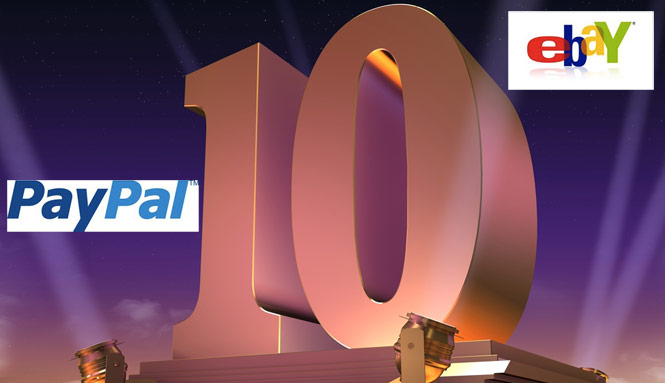
I’m talking, of course, about PayPal, the “subsidiary” that now accounts for well over a third of eBay’s total revenue — and gaining.
[aditude-amp id="flyingcarpet" targeting='{"env":"staging","page_type":"article","post_id":486280,"post_type":"story","post_chan":"none","tags":null,"ai":false,"category":"none","all_categories":"business,entrepreneur,mobile,","session":"B"}']Since the deal completed, PayPal has moved more than half a trillion dollars in payments and grown from 23 million regular users to over 110 million. VentureBeat spoke to PayPal’s senior director of global communications, Anuj Nayar, about the anniversary.
“There’s very few of these acquisitions that are universally seen as a success story,” Nayar said. “But eBay buying PayPal was maybe the most successful acquisition in Silicon Valley history. PayPal now accounts for 38 percent of the total company’s revenue.”
AI Weekly
The must-read newsletter for AI and Big Data industry written by Khari Johnson, Kyle Wiggers, and Seth Colaner.
Included with VentureBeat Insider and VentureBeat VIP memberships.
The purchase price was $1.5 billion dollars, but not a penny was actually paid. Instead, the deal was a tax-free stock-for-stock exchange: .39 eBay shares for every PayPal share.
In return, PayPal has generated about $20 billion in revenue for eBay over the past decade. In fact, this year alone PayPal expects to process more than three times the initial purchase amount — $7 billion — in mobile payments alone.
There’s some irony there, as Nayar notes:
“In 1998 the original business model was to move money between two Palm Pilots … and the online payments was a side business.” Now, he says with a trace of humor, “the hot new thing is to use your mobile phone as a wallet.”
Money on a mobile device is essentially how PayPal began. And a recent re-organization by PayPal president David Marcus has refocused the company on mobile, putting former mobile chief Hill Ferguson in charge of all PayPal product groups.
It’s a needed change, says Nayar.
[aditude-amp id="medium1" targeting='{"env":"staging","page_type":"article","post_id":486280,"post_type":"story","post_chan":"none","tags":null,"ai":false,"category":"none","all_categories":"business,entrepreneur,mobile,","session":"B"}']
“The payments market is getting more and more competitive … every morning I check VentureBeat and there’s another digital wallet company starting up. We are definitely doubling down on accelerating innovation.”
Of course, it’s not just small startups challenging PayPal.
As we reported late in June, competitors include Facebook, Google, and Apple. None of those are competitors to be taken lightly. One owns the world’s largest social graph, and the other two have a stranglehold on the mobile devices that hundreds of millions of people currently use … and billions more probably soon will.
Nayar knows PayPal is in for the fight of its life but likes the company’s chances.
[aditude-amp id="medium2" targeting='{"env":"staging","page_type":"article","post_id":486280,"post_type":"story","post_chan":"none","tags":null,"ai":false,"category":"none","all_categories":"business,entrepreneur,mobile,","session":"B"}']
“There’s a very different level of consumers buying in when you’re talking about your money. You need scale and you need trust.”
PayPal will need to grow both of these to have a future decade as successful as its past decade.
A brief history of PayPal:
- 1998: Peter Thiel and Max Levchin develop a service named PayPal as a secure way to beam money between Palm Pilots
- 1999: Nokia Ventures and Deutsche Bank “beam” Peter Thiel $4.5 million in venture funding from a Palm Pilot
- 2000: PayPal enables eBay payments
- 2001: PayPal goes public on the NASDAQ
- 2002: eBay acquires PayPal for $1.5 billion and begins to integrate PayPal into eBay
- 2004: PayPal launches its first API and introduces Web Services
- 2005: PayPal introduces micropayments
- 2010: PayPal launches the new Send Money application for mobile devices, processes $750 million in mobile payments
- 2011: PayPal processes $4 billion in mobile payment volume for the year
- 2012: PayPal partners with Home depot: can be used for payments at 2000 stores
Image credit: Sebastian Kaulitzki/ShutterStock
[aditude-amp id="medium3" targeting='{"env":"staging","page_type":"article","post_id":486280,"post_type":"story","post_chan":"none","tags":null,"ai":false,"category":"none","all_categories":"business,entrepreneur,mobile,","session":"B"}']
VentureBeat's mission is to be a digital town square for technical decision-makers to gain knowledge about transformative enterprise technology and transact. Learn More